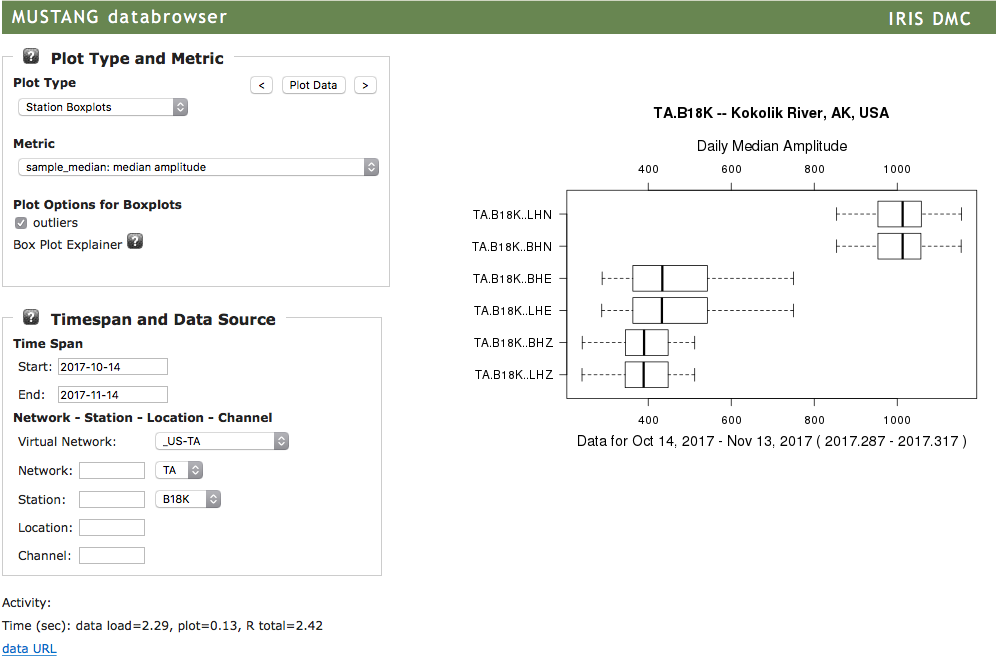Recent Releases for MUSTANG-related Quality Assurance Tools, Web Services, and Software
Over the past several months, a number of improvements have been made to MUSTANG-related quality assurance tools and webservices at the IRIS DMC. These changes include updates to the MUSTANG Databrowser, new features added to the MUSTANG noise-mode-timeseries web service, and the official release of ISPAQ.
- ISPAQ (IRIS System for Portable Assessment of Quality) was released in June, 2017. ISPAQ is a command-line application that enables users to calculate MUSTANG-style metrics for miniSEED data on local disk or accessible from any data center supporting FDSN web services, including SeisComp3 fdsnws. Over 40 metrics are available, using the same algorithms that MUSTANG employs, and the output is CSV text files which can be readily imported into other analysis tools. ISPAQ can also calculate Power Spectral Densities (PSD) and Power Density Functions (PDF), although the latter is currently limited to single day extents. This software is intended for anyone who needs metrics for data that is not in the IRIS archive or for which MUSTANG metrics are not otherwise available. ISPAQ can be found at https://github.com/iris-edu/ispaq.
- A new version of the MUSTANG noise-mode-timeseries web service was released in August, 2017. The noise-mode-timeseries web service returns daily PDF mode values in text, XML, or plot format; it is available at http://service.iris.edu/mustang/noise-mode-timeseries/1/. This release has two new features: the option to select frequencies or periods based on a range and the option to subtract a noise model from the daily PDF mode output.
A frequency or period range is denoted with brackets such that the web service will return daily PDF modes for all frequencies/periods between the specified limits. For example, “periods=[1,10]” will return values for all available periods between 1 and 10 seconds whereas “periods=1,10” will still return only the values at 1 and 10 seconds.
Users can now difference the daily PDF output from a high noise model (“output=powerdhnm”), a low noise model (“output=powerdlnm”), or both (“output=powerdnm”). When differenced from both a high and low noise model, the service returns a positive value if the daily mode is greater than the high noise model, a negative value is the daily mode is less than the low noise model, and zero if the daily mode value lies between the two noise models. This feature allows for the rapid identification of days where the PDF modes are noisy or quiet relative to the models. By default, the noise-mode-timeseries service uses the New High and New Low Noise Models (Peterson, 1993) but there is also an option to specify one or two custom models. One example of a custom model could be the average PDF mode for a network, which would produce a comparison to an average station noise level.

http://service.iris.edu/mustang/noise-mode-timeseries/1/query?target=TA.G24K..BHZ.M&starttime=2017-04-01&endtime=2017-08-01&output=powerdlnm&format=plot&plot.title=Daily+PDF+Mode+Differenced+from+the+New+Low+Noise+Model&periods=0.1,1,10,100
- A new version of the MUSTANG Databrowser was released in November, 2017 and is available at http://ds.iris.edu/mustang/databrowser/. The MUSTANG Databrowser is a client tool that retrieves MUSTANG metrics and creates metric time series plots and boxplots. As graphical representations of statistical quartile distribution, boxplots show the median value, the interquartile range (spanning the Q1 and Q3 quartiles), the extent of 1.5 times the interquartile range, and optionally any remaining outliers. The new improvements are aimed at making the Databrowser more responsive and useful, and this release fixes several issues that previously limited its utility. It includes a more complete list of metrics, with all metrics available except for the orientation_check metric which is not suited for simple plots. This version also filters the network, station, location, and channel selection drop-down lists by the requested start and end-times. Previously, the Databrowser included all stations in a network regardless of whether those stations had metadata dates that intersected with the desired time range, which could make the lists unreasonably long. Another addition aimed at ameliorating long drop-down lists is the introduction of optional text boxes where the user can type in the network, station, location, and channel. The text box will search the time filtered list and suggest matches to the input that the user can then select. Finally, the Databrowser has added support for virtual networks by including a new virtual network drop-down list that will filter the other data source selection boxes. This addition also allows users to create network boxplots that include all stations in a virtual network.

References:
Observations and Modeling of Seismic Background Noise, Jon Peterson, 1993.
by Gillian Sharer (IRIS Data Management Center)






